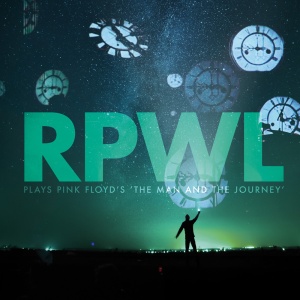Review by: B.B. Fultz
Assigned by: Roland Bruynesteyn

Spoiler Alert : as implied, this album is based on earlier works by Pink Floyd. There are a number of familiar Pink Floyd songs rehashed for this project, most of them with title changes. A lot of the “fun” of the album is listening to a piece and seeing how long before you recognize the song. Many are immediately recognizable, some take longer. And a few are just sections of songs, or unexpected combinations of two or three songs. My review will give away most of the surprises, so I recommend listening to the album BEFORE you read the review. I know that saying “don’t read this review right now” is a weird way to begin a review, but I think it’s worth mentioning. If you’re wondering whether my review is positive or negative, be assured it is mostly positive, and this album is highly recommended for anyone with even a remote interest in Pink Floyd. So go listen to it first. What follows is my actual review …
RPWL is a German progressive rock band formed in 1997. They began as a Pink Floyd tribute band before branching off into their own music a few years later. This album was their most recent (2016), and I have to say I liked it a lot. Imagine a band more technically gifted than Pink Floyd, remaking old Pink Floyd songs — and not even the well-known versions, but little-known “alternate” versions from an obscure soundtrack project — and you know it’s going to be interesting. What follows is like a Twilight Zone-ish journey of familiar Pink Floyd songs with an air of unfamiliarity. It’s often a dizzying effect, because just when you think you know what’s coming next, they switch things up and the song will take a weird twist. I don’t know the original Pink Floyd project, so my expectations are of necessity based on the Piper/Saucerful/More/Ummagumma versions of these songs. I don’t know what parts the RPWL guys improvised and what parts are exact copies of the original music, so I’m just judging the songs as exactly what I’m hearing at the moment … whether the original Pink Floyd versions were better or worse (or equal) I’m not able to say.
The songs, and thus the journey, are mostly wordless. The music is largely based on atmosphere and special effects (as might be expected for 60s Pink Floyd). They do a good job with these effects. “Work” is especially well-crafted, with rumbling motors, pneumatic drills, bell strikes, train squeals, and precise percussion like falling hammers … a condensation of all the sounds of human labor in the industrial age. I’m not sure that it needs the funky guitar break near the beginning — it’s rhythmic enough on its own without obvious musical instruments barging in on it. Another “non-musical” song is “Doing It,” with sharp drumbeats and timpani strikes backed by strange droning that fades in and out. There’s a sense that it’s going somewhere rather than just meandering, but who can say where? Unlike “Work” with its obvious industrial noises, the message in “Doing It” is unclear. Who is doing what, exactly? Beats me.
Then there are the songs that sound like Pink Floyd songs, but only peripherally. “Sleep” is maybe the most effective, with its breathing sleeper, ticking alarm clock, eerie drugged-out synth background, and a growing sense of tension … which is to say, the beginning of “Time” crossed with the trippiest parts of the “More” album and dropped into the growing chaos of the first movement of “A Saucerful of Secrets.” The effect is an effective, even breathtaking synthesis of the three into an almost nightmarish sense of rushing forward (so throw in “On The Run” too, which it closely mimics).
Some sound like fragments of Pink Floyd mixed in with foreign elements, like “The Labyrinths of Auximines” which is an indescribable (for me) combination of the midsection of “Echoes” + piano riffs from the Bowie song “Aladdin Sane” + the descending space beeps from Steve Miller’s “Fly Like An Eagle” (yes it’s that weird) … or “The Temple of Light” which sounds like the trippiest effects from More with somebody playing a warbly guitar line over them … or the brief intro “Daybreak Pt 2” which is the birdsounds from “Cirrus Minor” over the familiar ticking alarm clock. These are more like half-baked ideas than actual songs, but they’re never boring.
And then there are the standard Pink Floyd songs, or combinations of such songs. Some are more instantly recognizable than others. It took me awhile to realize “Daybreak Pt 1” is Roger Waters’ “Grandchester Meadows” (maybe because I haven’t listened to Ummagumma in ages). For the same reason I didn’t immediately recognize David Gilmour’s “The Narrow Way” — in fact I only knew it because they kept the title. I also probably couldn’t place “Beset By Creatures of the Deep” even though I actually HAVE the song on a rare Pink Floyd 60s bootleg of the same title, because I haven’t played it for so long … only the “Eugene-sampled” bass-line was familiar to me. It sounds like Eugene but it’s not Eugene.
On the other hand, “Nightmare” is VERY obviously “Careful With That Ax Eugene,” but with weird backward fade-in synths. You expect the shrieking climax in Eugene; here it can actually come as a surprise, because you forget you’re listening to Eugene and start thinking it’s something else. And then, even more surprisingly, it suddenly turns into … “Cymbaline”(!) I don’t mean something “like Cymbaline” either. I mean actually “Cymbaline,” lyrics and all. But with a very long (and honestly, a really good) jazzy guitar solo smack in the middle. It sounds like how I imagine a live version of that song would sound if played by Floyd in the 60s. All these dissonant elements sound like they shouldn’t work together, yet somehow, they do. The only fault with this song is the name — there’s nothing AT ALL Nightmarish about any of this. The Nightmare title would be far more apt for the previous song “Sleep” with its palpable sense of impending danger.
Likewise, “Afternoon” is simply a leaner and harder version of “Biding My Time,” which strays a little too far from the N’orleans jazzy charm of the original, especially when newer production techniques give it that cramped, heavy, on-top-of-itself sound. This sense of the music standing on top of itself occurs in a number of the songs, to a greater or lesser degree. It’s one of the few things I DON’T like about the album. Some music will work that way, but with Pink Floyd, the result is often more headache-inducing than impressive.
“The Beginning” — which for some reason is the eighth track instead of the first — was one of the coolest surprises, for me at least, because it’s “Green Is The Colour,” one of my very favorite Pink Floyd songs (easily the best song on More; I’ll take it over “Cymbaline” any day). This version is good enough in its way, although the percussion is too crash-bangy for such a tranquil song, and it’s another case where the music gets on top of itself as it goes along. It falls way short of the original, but it’s still a really good song because it’s based on a really great song.
“The Pink Jungle” is “Pow R Toc H” from the first album. It begins with a background of jungle noises that runs for the entire song. The music sometimes seems to fall in sync with that jungle background, reminding me of “Several Species …” and how nature-rhythms influenced man and eventually led to man-made rhythms. I was never a huge fan of the original Pow R Toc H, so I can’t find fault with the cover. At least the cover has less of those stupid “doy-doys” (a good thing in my book).
Finally, it all ends on “The End of the Beginning” … another one of the best surprises, as this one is the third movement of “A Saucerful of Secrets,” a song that I love in its entirety. This version is more grandiose than the original, since it’s the grand finale of the album. The sound is big and immediate, with a driving boom-bap percussion that seems out of place here, considering the original is very solemn and was literally meant to be a funeral dirge after a battle. It has that “stage Floyd” sound of that era, so much so that I wasn’t even surprised when a previously undisclosed audience began cheering at the end. I already suspected it was a live performance. It just “sounds” live, you know? Still and all, a reasonably good ending for a very good album.
If you’re a Floyd fan, especially of their 60s output, you really need to hear these guys. They’re skilled musicians with a good ear for this type of music, and this album is an obviously loving tribute to their biggest influence, something that only the most ardently purist and fanatical Floydhead could object to. It’s a strange and compelling thing, hearing these songs twice removed … once when Pink Floyd reinterpreted them for the soundtrack, and again when RPWL covered them here. It’s a surreal musical trip when you recognize something but it sounds alien at the same time, or when one Floyd classic morphs into another without warning. The unpredictability of the whole thing is the fascinating part, so much so that I was compelled to add that disclaimer, because I’d feel guilty if I robbed the newcomer of that sense of surprised wonder.
If you like Floyd — or even if you just have a taste for interesting progressive rock / art rock projects with intelligent production and rich tapestries of sound — then RPWL is well worth getting to know. And there’s no better place to start than here.

